FORT EUSTIS, Va. — Army senior leaders have approved a new strenuous fitness test designed to better prepare Soldiers for combat tasks, reduce injuries and lead to ample cost savings across the service.
The six-event readiness assessment, called the Army Combat Fitness Test, is intended to replace the current three-event Army Physical Fitness Test, which has been around since 1980.
Beginning October 2020, all Soldiers will be required to take the new gender- and age-neutral test. Before that, field testing set to begin this October will allow the Army to refine the test, with initial plans for up to 40,000 Soldiers from all three components to see it.
“The Army Combat Fitness Test will ignite a generational, cultural change in Army fitness and become a cornerstone of individual Soldier combat readiness,” said Maj. Gen. Malcolm Frost, commander of the Army’s Center of Initial Military Training. “It will reduce attrition and it will reduce musculoskeletal injuries and actually save, in the long run, the Army a heck of a lot of money.”
At least six years of significant research went into the test’s development as researchers looked at what Soldiers must do fitness-wise for combat.
“Throughout that research and testing, the goal was to provide our leaders with a tough, realistic, field-expedient assessment of the physical component of their Soldiers’ individual readiness,” said Sgt. Maj. of the Army Daniel A. Dailey. “The ACFT is scientifically-validated and will help better prepare our Soldiers to deploy, fight, and win on any future battlefield.”
Roughly 2,000 Soldiers have already taken the test, previously called the Army Combat Readiness Test. They also provided feedback as part of the Army Training and Doctrine Command and Forces Command pilots that began last year at several installations.
“The current PT test is only a 40 percent predictor of success for performing in combat and executing warrior tasks and battle drills,” Frost said. “This test is approximately an 80 percent predictor of performing based on our ability to test the physical components of combat fitness.”
SIX EVENTS
While the ACFT still keeps the 2-mile run as its final event, it introduces five others to provide a broad measurement of a Soldier’s physical fitness. The events are completed in order and can take anywhere from 45 to 55 minutes for a Soldier to finish.
— Strength deadlift: With a proposed weight range of 120 to 420 pounds, the deadlift event is similar to the one found in the Occupational Physical Assessment Test, or OPAT, which is given to new recruits to assess lower-body strength before they are placed into a best-fit career field. The ACFT will require Soldiers to perform a three-repetition maximum deadlift (only one in OPAT) and the weights will be increased. The event replicates picking up ammunition boxes, a wounded battle buddy, supplies or other heavy equipment.
— Standing power throw: Soldiers toss a 10-pound ball backward as far as possible to test muscular explosive power that may be needed to lift themselves or a fellow Solider up over an obstacle or to move rapidly across uneven terrain.
— Hand-release pushups: In this event, Soldiers start in the prone position and do a traditional pushup, but when at the down position they release their hands and arms from contact with the ground and then reset to do another pushup. This allows for additional upper body muscles to be exercised.
— Sprint/drag/carry: As they dash 25 meters five times up and down a lane, Soldiers will perform sprints, drag a sled weighing 90 pounds, and then hand-carry two 40-pound kettlebell weights. This can simulate pulling a battle buddy out of harm’s way, moving quickly to take cover, or carrying ammunition to a fighting position or vehicle.
— Leg tuck: Similar to a pullup, Soldiers lift their legs up and down to touch their knees/thighs to their elbows as many times as they can. This exercise strengthens the core muscles since it doubles the amount of force required compared to a traditional situp.
— 2-mile run: Same event as on the current test. In the ACFT, run scores are expected to be a bit slower due to all of the other strenuous activity.
The ACFT gauges Soldiers on the 10 components of physical fitness: muscular strength and endurance, power, speed, agility, aerobic endurance, balance, flexibility, coordination and reaction time. The current test only measures two: muscular and aerobic endurance.
TEST SCORING
The vast majority of policies with the APFT will likely be carried over to the new test.
Scoring could be similar with 100 points for each event for a maximum of 600. Minimum scores, however, may change depending on a Soldier’s military occupational specialty. Soldiers in more physically demanding jobs may see tougher minimums, similar to how OPAT evaluates new recruits.
“The more physically challenging your MOS, the more you’ll be required to do at the minimum levels,” said Michael McGurk, director of research and analysis at CIMT.
Another difference is that there are no alternate events planned for this test, he said.
Soldiers will still get adequate time to rehabilitate from an injury. But under a new “deploy-or-be-removed” policy, Defense Secretary James Mattis said in February that troops who are non-deployable for more than 12 months will be processed for administrative separation or referred to the disability evaluation system.
“Generally speaking, somebody who has a long-term permanent profile that precludes taking a fitness test may not be retainable for duty in the Army,” McGurk said.
At about $20 million, the new test will be more costly for the Army to conduct. A single lane of equipment at full retail value is about $1,200. A battalion set of equipment will range from $12,000 to $20,000. Those prices will likely drop as the Army buys more sets at wholesale.
Equipment should last about 10 years, meaning it will cost less than $3 per Soldier over time.
“If I have a femoral neck fracture in the hip of a Soldier, that injury will cost the government about $1 million,” McGurk said. “So, if I avoid 20 of those injuries a year I’ve paid for the program for the next 10 years for equipment. The potentials on return are very significant.”
COST AVOIDANCE
The Army estimates $4 billion is spent each year due to injuries, non-deployable Soldiers, accidents and other health-related costs.
As part of its culture change, the Army is building a Holistic Health and Fitness System to produce healthier and fitter Soldiers. The new test is one piece of the system, in addition to the OPAT, the improvement of fitness centers, and healthier options at chow halls.
Army researchers studied foreign militaries that have rolled out similar holistic programs and found them to be highly successful.
The Australian army, for instance, introduced it to their basic training and saw a roughly 30 percent reduction in injuries.
“Do I know we’re going to have a 25-30 percent reduction? No, but I certainly hope we will,” McGurk said. “We think [the test is] well worth it and it’s the right thing to do for Soldiers in any case.”
Feedback from Soldiers so far has also been overwhelmingly positive.
“As we all know, physical fitness training can become rather monotonous if people train the same way,” McGurk said. “So, a lot of them saw this as a great change and how it required them to use different muscles.”
While some Soldiers may disagree with replacing the current test, McGurk said that fitness has come a long way from 40 years ago when the APFT was first developed.
“In 1980, running shoes were relatively a new invention,” he said. “The Army was still running in boots for the PT test back then. Change is difficult, but we’re an Army that adapts well to change.”
ARMY VISION
In early June, senior leaders outlined what the Army should focus on over the next decade to retain overmatch against potential adversaries.
The 2028 vision statement, signed by the Army’s secretary and chief of staff, calls for modernized equipment, particularly the development of autonomous systems. It also stresses the need for physically fit and mentally tough Soldiers to fight and win in high-intensity conflict.
“Technology is going to be dominant and we need a lot of things that we’re looking at through modernization,” Frost said. “In the end, you still need the United States Army Soldier to be able to seize and hold terrain.”
The ACFT is a foundational method, leaders believe, that the Army can use to start a new era of fitness and obtain Soldier overmatch in combat.
“The current leadership … has really coalesced and understands the importance of fitness itself and the importance of the PT test to drive that change in culture,” Frost said. “They’ve made the decision and we’re ready to execute.”
By Sean Kimmons, Army News Service


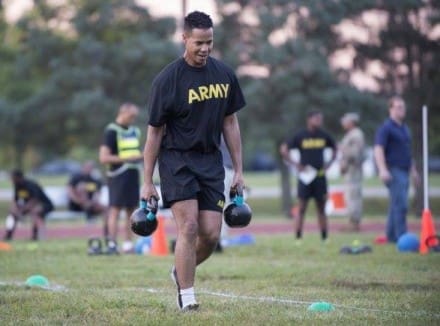
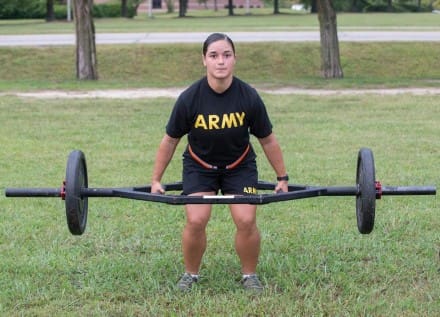
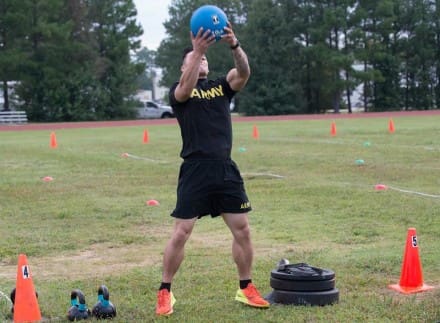
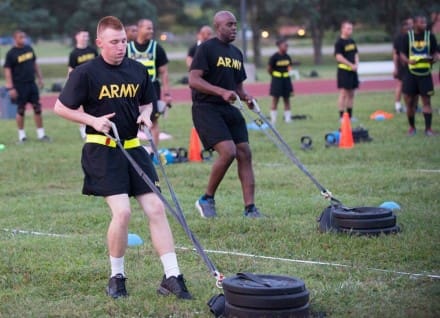
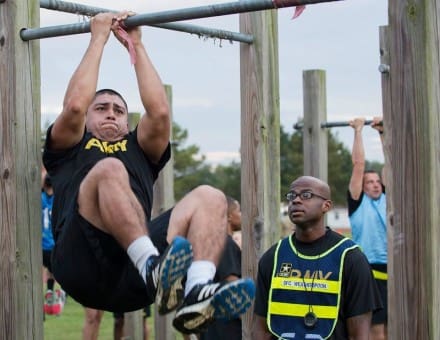
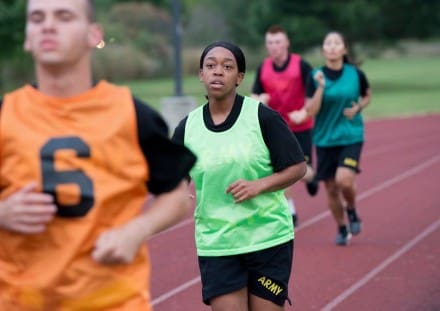
Up to 420lbs, on deadlifts gender and age neutral. I think 420lbs to max deadlift might cause some issues. What weights 420lbs in combat that ONE soldier needs to lift three times? I rather have Solider that lifts 315lbs 3x and be 2mins faster on 2 mile run. 315lbs is average weight of full equipped Ranger medium machine gunner.
The deadlift isn’t just an exercise, it’s an expression your coordination under stress and posterior chain strength. In other words, if you can deadlift a lot of weight, then you’re probably good at a lot of other stuff as well.
Also, doing a 3RM test is a safer way to test strength than a 1RM test.
I am aware of the benefits of the 3 rep max, and deadlifts are one of the best functional lifts you can do…….. my point was that deadlifts cause more injuries in the gym over the last 10 years (according to THOR data) than any other exercise and that’s with more elite units that have better training, equipment, facilities and funding. I strongly believe this is a great direction the Army is going in, but someone needs to tell the emperor when he is naked.
If that was your point, you didn’t make it. You said nothing about injuries in your original post.
The trap bar, I ASSUME, is meant to shorten the learning curve on the deadlift and reduce injuries.
Well said, D.
“What weights 420lbs in combat that ONE soldier needs to lift three times? I rather have Solider that lifts 315lbs 3x and be 2mins faster on 2 mile run. 315lbs is average weight of full equipped Ranger medium machine gunner.”
People are inevitably going to get wrapped around the axle on the new PT test.
Just to address 4XRanger.
1) There’s nothing stopping the person that can lift 420lbs for multiple reps from running a fast 2 mile. It’s not a zero sum either/or game.
2) All other things being equal, stronger is better – there can be no debate –
Don’t look at it as “A machine gunner and gear weights 315lbs so that’s all one needs to deadlift.” Eeking out a 315 deadlift doesn’t mean you are going to be able to throw a casualty over your shoulder like a sack of dog food and run out of the kill zone. But it’s going to be more likely that the guy with a 420lb 3RM can do it compared to a guy with a 315lbs 3RM.
I wouldn’t set the goal max weight at 315lbs considering that that’s an easily reached number within a year or two of weight training for a decent sized male. Will all recruits be able to pull 315lbs at the end of Basic? No, many won’t be able to. But they will go far past 315lbs eventually with sensible programming.
3) Strength doesn’t have to come at expense of the other needed attributes (strength endurance, straight endurance, speed) If someone truly gears his PT program to excel in this test, then the 2-mile run test and other events prevent it from being biased toward powerlifters and “meatheads”.
4) I can’t tell you how many times I’ve heard someone say “I’ll never run 2 mile in combat. The 2-mile run is stupid” Goes to show you can’t please everyone (and no it’s not useless. Its a pretty good predictor/indicator of endurance.) I just say that to point out that this test won’t please everyone either.
Change is hard.
Well said! The ‘ can’t ‘ mentality in today’s military escapes me! We did the CPAT my last two years in the Army, so I were still end, I know I could score high on this with some practice and technique. Put some DFND compression on afterwards for recovery, hydrate/fuel, sleep, repeat faster!
So someone like me who is 52 years old (Still in Army Reaerves) and has a permanent profile for bad knees and can’t do some of these tests, means I automatically get kicked out. Doesn’t sound right to me. I can still pass the current APFT by the way.
Sorry John. I know it doesn’t sound right but it is. Sometimes it’s just time to go my friend. I’m close behind you and retirement eligible. I’m anxiously hoping the army actually does this test the way they are claiming they will; gender and age neutral. I don’t think they will. I think they will cave at the first sign of pushback from the old guard and the women.
The Corps could learn a thing or two from the army on this one. The “new pft” started out gender neutral until a bunch of female officers told the commandant they’d quit if they had to do as many pull ups as men. He should have said see ya and thanks for your service.
I also think TW army is on to something with different requirements for different mos. hope they increase pay for those hard to achieve mos to encourage participation.
I agree what they are doing, but I already have the bad knees and profile, so not much I can do. I have 7 years left to get my 20 year letter and I’m an MP, so I am sure I will have the harder one to do. I guess I’ll get in better shape and do the best I can. I don’t want to have gone this far and be booted out.
IF the Army doesn’t waffle on this test, the effect I think we’ll see in the next few generations will be fewer knee issues and profiles.
How many Soldiers have knee issues because of the Army’s fixation on running?
First: D, the new test still has a 2-mile run.
Second: Reform Nova, most general officers are in their fifties, and their joints are showing the mileage. Time for them to go?
It is absolutely time for many of them to go. I’d say you could easily trim the GO corps by 20% with no real loss to Army capabilities.
Well, Jeremy, you get to tell them that the Army no longer needs them around. I work and live in the real world, where things are what they actually are, not what I think they should be or what I wish they were.
I will believe it when I see it. I have my doubts the Army can field the equipment in time for Soldiers to actually train with it (especially in Reserves and Guard). I bet the timeline gets pushed. Queue the massive #s of LODs after the first test and the massive drops in readiness #s…..
I agree with your assessment. This will be another grand Army belly-flop of distraction for a couple years before quietly being faded away. It’s all just…”too much”.
And another thing. There was a quote in the article about a “femoral neck fracture in the hip of a Soldier” costing the Army about $1 million dollars. Damn. There’s more than a few young female soldiers (mostly enlisted) who we break with this exact injury. I personally know a couple of them, and while it might cost Big Army “one millllion dollars”, I know that these young ladies are sent home with a lifetime of pain-when -it-rains, and nothing close to a million dollars in treatment, compensation, nor (I believe) in deliverable lifetime VA benefits. Perhaps someone knows where all the money goes…
I figure it will take the Army about five years to fully implement this and at about that time commanders will have had enough of the distraction and the promotion and retention systems will be in such upheaval that it will go away at about the same time.
I agree it wont make it far without major revision and/or redaction. Even with the AF, civilian proctors didn’t even make it past two years but the new mins did stick.
I can’t imagine they’d do something like this without expecting on-paper readiness to drop… Institutional momentum is hard to break after all, and even if the equipment gets to units, they won’t transition to it with perfect integration immediately.
So good leaders, knowing that there is a two year window for preparation, won’t begin integrating these exercises or accessory exercises until the hammer falls in 2020?
You don’t even need the equipment to begin. You can do most of the weighted exercises using sandbags, water cans, and skeds. You only really need the gym for deadlifts.
There’s lots of time to start light, practice good form, and build into success at the unit level by time this goes into effect.
How do you conduct the test deployed?
Two options I can think of:
A) You go to the gym on your FOB and do the test. How many people take the test at a given time would be determined by the available facilities.
B) Units take the test prior to deploying and give a waiver for the length of the deployment.
(-face palm-)…let’s review what the current APFT is, and what it is not.
The APFT is: The APFT is a quick snapshot of a soldier’s level of physical fitness. There is no special equipment required, and the APFT can be conducted wherever you can find a flat 2 mile run route.
The APFT is not: A commander’s sole means to determine physical fitness and combat readiness.
Bottom line…this new test requires equipment and more time, and can only be conducted with that equipment, and shows that that Army leadership does not believe that unit leaders can design and conduct proper PT which prepares soldiers to execute their mission and duties.
The “APFT isn’t” ship sailed as soon as it became a promotion point generator……….
That said, is this test a better diagnostic tool for a commander, regardless of the added equipment costs? Does it concentrate on more meaningful activity than the current lots of push-ups and sit-ups? APFT is great because it can be done anywhere, this looks like it provides better data, and pushing leaders to get better metrics for their units pushes them to develop PT plans that are better aligned to functional needs on the job.
So for the record, you’re saying that most unit pt programs are effectively tailored to MOS performance and not just catered to readiness metrics that commanders are held accountable for?
The real bottom line is that holistic health and wellness is an emerging issue for readiness as a result of systemic issues with how the force is programming physical training, among other things. the APFT is not a quick snapshot of soldier fitness; it is only a good measure of the things it measures, which do not reflect the physical requirements of soldiers on the battlefield or many MOS specific tasks. If you are as you say, a man who works and lives in the real world where things are what they actually are and not what you want them to be, I encourage you to call the Army Physical Fitness School on Ft. Jackson for more information.
Some Other Joe and Tech,
If there are leadership issues, it’s best to address those issues, rather than try to circumvent those issues. The fact that the APFT figures into promotions needs to be addressed/discussed on its own merit.
If “the real bottom line is that holistic health and wellness is an emerging issue for readiness as a result of systemic issues with how the force is programming physical training,” fine…address that issue. A new PT test doesn’t address that issue.
I don’t need to call Fort Jackson to figure out anything. Every problem in the military is, at its core, a leadership problem. Both of you (Some Other Joe and Tech) are identifying leadership problems, and you are proposing that a new PT test as a solution?
I think my sit up record was pretty high, but I’d probably be chaptered failing that knees-to-nose legup.
Most of the other stuff doesn’t sound terrible, but hey, that’s why the 2 mile run is still there!
“You can add to the standard, but not take away.”
Injuries from running too much will exist so long as unit leadership sees PT as a pissing contest.
The Army should think about using a regular Olympic barbell for the deadlift. Straight bars are much more common and cheaper and the mechanics of the trap bar are actually closer to a squat than a deadlift. I’m curious if anyone knows the reason why the trap bar was chosen over a straight bar.
For that exact reason and because the Army believes it will hurt people less. Mechanics of the trap bar deadlift favor overall leg and hip strength rather than back and posterior chain for the traditional deadlift.
Probably because of the grip position. Trap bar better simulates the grip you would use when “picking up ammunition boxes, a wounded battle buddy, supplies or other heavy equipment.” Other then that, maybe it’s been shown that trap bars results in less injuries over time or is easier to teach.
It shouldnt cost that much for that eqipment. But either way I love it. Most units already have the hexbar, kettlebells, MBs, and sleds. I applaud this and its about time. I know the Ranger Bats already do this type of training and have been for quite a while. As for those that cant deploy and end up getting removed, its a high risk game and I applaud this also. The miitary is there to defend this country and they need to be 100% capable and ready to go.
You have to have THE items, not similar items. Measurements that are tied to promotion and retention must be equitable across the force.
I’d like to see where you are getting your data that “most” units have the equipment alredy.
The number of graders for this seems impractical, as the events are various lengths and only one is congruous with the average break length you would need to have one grader per soldier. The test is designed to take 45-50 minutes depending on how fast the 2-mile run goes. This seems to me as though we’re looking at a grader being able to do one iteration every 50 minutes. Am I missing something?
Honestly, I’m kind of laughing at the bitching, even though that’s what Joe does.
I believe the changes are welcome and the new test is a good one. It’s about people having the fortitude to stick with it and perhaps changing some of the things around it that are consequential.
In the end it’s about readiness, and if your unit doesn’t have a population that isn’t ready to deploy or soldiers riding the injury cycle, congratulations.
I still don’t get the new pushup, but that’s just me. Years ago someone from the 75th taught me how to do a real pushup. I was on about #30 of my pushup before he counted 1. If you’re already doing them right this is not really harder, just different.
The leg tuck is a little awkward. But if you do regular pullups and work core it’s more an adjustment than anything.
It’s kind of hilarious watching people twist themselves into pretzels with the argument we should have one standard, but you know I have “X’ problem that will make me fail, so yeah change that.
So, the Army expects to evaluate the fitness of someone who’s fifty to the same standard as someone who’s 20? Also, the females will be decimated on a two mile run based on an identical standard. Look at the current scoring for male and females on the two mile run. Few females could meet the current male standard.
How does a Reservist or Guardsman train for this test without access to any of the equipment that will be widely available on active duty posts? None of this equipment is sitting around at Reserve Centers or Armories and Soldiers are only there once a month anyway. So how do you train for the deadlift without weights? The beauty of the current test is that you can train for the three events anywhere, on your own, and the test requires very little in the way of specialized equipment short of a stop watch which is now on every phone.
I also agree with an earlier post, you are going to need one hell of a lot of scorers to get even a company sized element through this test with two minute intervals between tests.
Current test is a measure of fitness, not performance. They’re not the same. Specificity is important yes, but if you got stronger, the granny/mb toss and trap bar deadlift should be a reflection of that strength.
Based on our current understanding of physical performance and preparation, if you’re in the military, you should be training with weights. Stronger athletes means less injuries and higher performance. You can get stronger without, but you’re gonna have a hell of a time trying.
“So, the Army expects to evaluate the fitness of someone who’s fifty to the same standard as someone who’s 20? Also, the females will be decimated on a two mile run based on an identical standard. Look at the current scoring for male and females on the two mile run. Few females could meet the current male standard.”
Are females capable of performing the same military jobs as males or not?
Sounds like winning to me. Level playing field. Now when your packet goes in front of a promotion board, you have a chance to stand out as a fit 30-50 year old amongst your peers of similar age.
I don’t think we can fully integrate females into combat arms and maintain standards for (unit) performance without holding everyone to the same physical standards.
There’s a major difference between a 30 year old and a 50 year old, especially if the 50 year old has injuries, particularly those generally associated with service.
Sounds great to run off all of those old folks. Except that they are your institutional memory. What’s more, the new retirement system is no longer 20 and out. They’ll need to serve longer for the ROI.
I used the 30-50 year range since that’s where the old/current chart starts to slide.
What I mean’t was that we’re often in the same age range as the others in our promotion peer groups and that the flat scoring system could really show a difference in two 30 something year old guys’ fitness.
I used the 30-50 year range since that’s where the old/current chart starts to slide.
What I mean’t was that we’re often in the same age range as the others in our promotion peer groups and that the flat scoring system could really show a difference in two 30 something year old guys’ fitness.
So the US Army has now gone full Crossfit.
Can you pay a 30-burpee penalty to skip an event you don’t like?
This is fstupid. Some bozo, who has nothing to offer the military but a ” crossfit can-do” mentality, came up with this for bullet points. Out of touch. Btw i been in 15 yrs- before some leg sjw,never OIF, new army soldier, chimes in about” this mans army”bs.
They want you to think some scientist or specialist came up with this, when in reality, they probably tasked out some lieutenant to walk down to the MWR and look for some douchebag. They took a pre-packaged program and slapped combat on it.
Not that I believe for a moment that exposure to the truth will make you feel dumb for running your uninformed cock holster, but the guy that helped lead the team in developing this test is a former Infantry officer with over 25 years of uniformed service and now leads the research & analysis directorate for the Army Initial Military Training Center.
Remember, the people that brought you the M16, the SGT York, and UCP were also “experts” with many years of service.
So now a company or heck even a platoon pt test will take an entire morning and probably some of the afternoon as well…..
Least the old test could be knocked out inside of an hour or two. Now? The sky is the limit.
Cheap, fast, good–you can only have two.
I’m still trying to figure out how our Reserve Component units are going to get this done.
They push 15 sets down for each BN – but I’ve got companies (and some of those are broken up into detachments) at least 100 miles / 1.5 hours or more away from each other.
We’ve only got 39 days a year. We had to take the APFT twice a year and I’m guessing the same for the ACFT. So we’ll likely consume 4-6 days out of our 39 taking ACFT.
Unfortunately, this issue is widespread. The centralreason the Army transitioned from the old 5 event test to the 3 event currently used was due to facilities. This new test is even more complicated.
During AOM weeks platoons have plenty of time to knock one of these out… we release guys to the gym at 1400 on slow days and that’s only so we don’t get hemmed up for releasing them right after lunch. Time management is a thing… it’s super useful.
Reserve units may have to hold a once every twelve month standard. Every armory I saw in the guard had a hex bar, weights, pull up bars, KBs, and other functional fitness equipment. My platoon maintained a 250 average and the weapons company held a 260 average doing the APFT at an armory that was at 7500 feet. Being fit and being a reservist are not mutually exclusive, developing a culture pays dividends.
I’ve said for a long time that the Army needs to go to a gender- and age-neutral standard, and this looks like it is closer to that. The machinegun doesn’t magically lighten itself when a girl or an old fat bastard goes to pick it up. You can either do the job, or you can’t.
That said, I think they also need to start doing some long-term longitudinal studies, and start figuring out what specific body types and training issues create long-term health and fitness issues. One thing I noticed when I went to retire was that the bigger the retiree, the thicker the medical record, and the more injuries they had accumulated. Also, the only SF and Airborne types who had skinny medical jackets were all short and wiry dudes… And there were fuck-all for big guys over six feet that had managed a full 20 in SF or the Rangers.
Someone needs to look at all of this, and figure out why and how that happens. Once we know, then we can start looking at how to fix it, whether by better training or restrictive enlistment standards. It does the nation no good to consistently break a significant percentage of our enlistees and officers by trying to force them into jobs that their bodies cannot sustain over the long haul. At the least, we should be able to tell them that their chosen career field carries with it the statistical risk of long-term debilitating health issues for their body type.
Next to the ladies in the infantry noise and emotional camouflage melodrama, the silly annual individual PT test is probably the most f’ing tiresome debate (but thanks nonetheless to the editor for putting this one out there) in USDOD. How about a 365-day a year individual PT test called being a damned infantryman and doing your job? This one reeks of staff officer (he of the weak-chinned douche brigade who sit in front of computers day-night-NBC and collect paychecks for making the simple things complex) checklist mentality and looks like a game of whackbat to me. Units will burn too much training time annually making sure they can run this “6-Ring Circus” so General X gets a pretty chart telling him his troops are fit to fight (in shorts and reflective belts). Army should decentralize as much of the JV BS as it can: the beehive mentality doesn’t work. A PT test relevant to promotion should count for VERY little in combat arms fields (can’t/won’t speak for the others), maybe 5%, be simple and take about an hour…and require zero friggin’ limpwrist crossfitesque equipment to add to the T/E I’ve got to worry about, especially if YOU [GO’s] can’t take the initiative to give us a good CAS aircraft, rifle/ammo, LMG, boots and ruck….try worrying about the important issues before you get down in the weeds hunting for that little greasy roly-poly MF’er you suspect is hiding under a poncho unbeknownst to his NCO’s who will deep-six your grandly esoteric battle strategem because he doesn’t know how to do a proper blue-balled standing power throw. If the SgtMaj and COL and the folks they lead can’t figure out how to get their unit fitness standard where it needs to be to fight and win, it’s probably asking to much for them to deploy and expect to win on the battlefield.
I never understood why the Army spent millions of dollars developing this test when they already developed a great PT test in 1946 based on the experience of WWII. The test consisted of pull-ups, Squat Jumps, Push-ups, Sit-ups, and a 300 yard run. The rules for the test are very strict and there is no age standards or gender standards. Years ago, when I was still in, my team took it one day for PT, almost no one passed. Which, I now know why they Army would never bring it back…there would be like 18 people left in the Army.